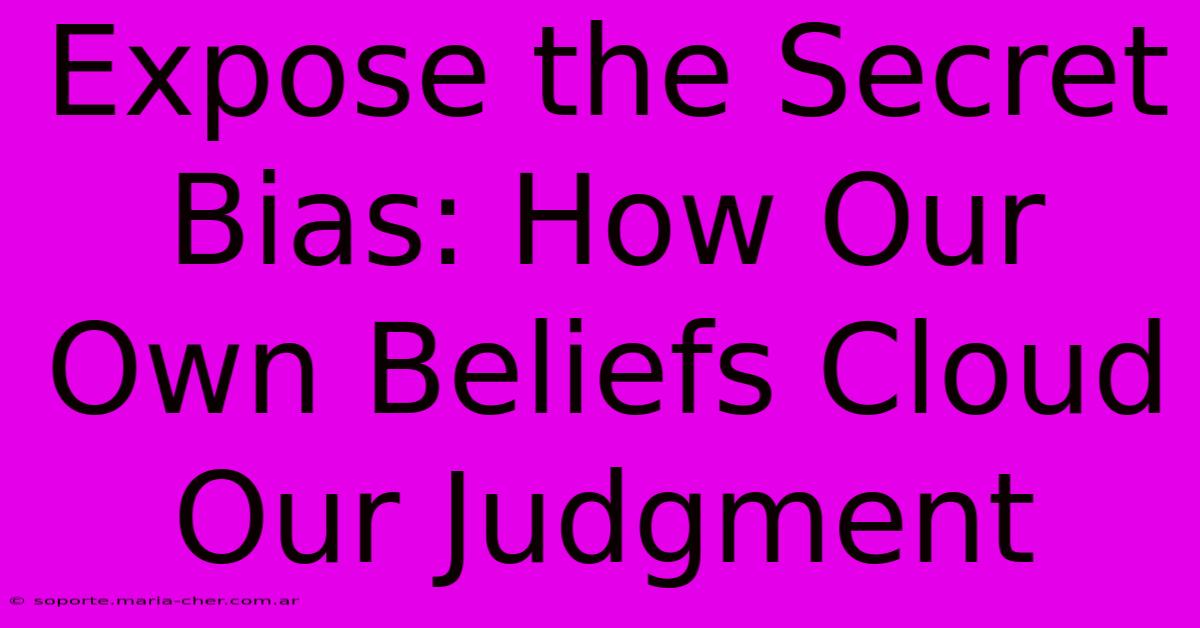Expose The Secret Bias: How Our Own Beliefs Cloud Our Judgment

Table of Contents
Expose the Secret Bias: How Our Own Beliefs Cloud Our Judgment
We all like to think of ourselves as objective, rational beings. We pride ourselves on making decisions based on facts and logic, free from the sway of personal biases. But the uncomfortable truth is that our beliefs, often formed unconsciously, profoundly influence how we perceive the world and make judgments, often leading to inaccurate conclusions and unfair actions. This article delves into the insidious nature of cognitive biases and explores how to identify and mitigate their influence.
The Unseen Hand of Bias: Understanding Cognitive Distortions
Cognitive biases are systematic errors in thinking that affect our decisions and judgments. They're not simply mistakes; they're ingrained patterns of thought that operate below the level of conscious awareness. Understanding these biases is the first step towards overcoming them. Some of the most common include:
Confirmation Bias: Seeking What Confirms, Ignoring What Contradicts
This is perhaps the most pervasive bias. Confirmation bias refers to our tendency to seek out and interpret information that confirms our pre-existing beliefs while ignoring or downplaying information that contradicts them. We might selectively read news sources that align with our political views, for example, reinforcing our existing opinions and creating an echo chamber.
How to Combat it: Actively seek out opposing viewpoints. Challenge your own assumptions. Engage with diverse perspectives and be open to the possibility that you might be wrong.
Anchoring Bias: The Power of First Impressions
The anchoring bias describes our tendency to over-rely on the first piece of information we receive (the "anchor") when making decisions. This initial piece of information, even if irrelevant, can disproportionately influence our subsequent judgments. Consider a negotiation: the first offer often sets the stage for the entire bargaining process.
How to Combat it: Be aware of the influence of initial information. Actively seek out additional data points before making a decision. Consider alternative scenarios and perspectives.
Availability Heuristic: Recency and Vividness Matter
This cognitive shortcut relies on readily available information in our memory. We tend to overestimate the likelihood of events that are easily recalled, often because they are recent or vivid. For example, after seeing a news report about a plane crash, we might overestimate the risk of flying, despite statistically low chances.
How to Combat it: Seek out statistical data to counterbalance anecdotal evidence. Consider the base rate of an event – its overall frequency – rather than relying solely on memorable examples.
The Ripple Effect: Bias in Action
The consequences of unchecked biases extend far beyond personal decision-making. They can significantly impact:
- Relationships: Biases can lead to misunderstandings, conflicts, and unfair judgments of others.
- Workplace: Hiring processes, performance evaluations, and promotions can be skewed by unconscious biases, leading to inequality.
- Social Justice: Systemic biases contribute to discrimination and prejudice in various societal spheres.
Breaking Free: Strategies for Reducing Bias
Overcoming our biases is an ongoing process, requiring conscious effort and self-reflection. Here are some key strategies:
- Develop Metacognitive Awareness: Regularly reflect on your thought processes and identify potential biases influencing your decisions.
- Seek Diverse Perspectives: Actively engage with people from different backgrounds and viewpoints.
- Embrace Critical Thinking: Question your assumptions and evaluate information objectively.
- Practice Mindfulness: Cultivating mindfulness can help you become more aware of your thoughts and emotions, reducing the influence of automatic biases.
- Use Data and Evidence: Base your decisions on objective data and evidence rather than intuition or gut feelings.
Conclusion: Recognizing and addressing our own biases is crucial for making sound judgments, fostering fairer relationships, and contributing to a more equitable society. By actively challenging our assumptions and seeking diverse perspectives, we can strive towards greater objectivity and make decisions that are both rational and just. The journey towards unbiased thinking requires continuous effort, but the rewards are immeasurable.

Thank you for visiting our website wich cover about Expose The Secret Bias: How Our Own Beliefs Cloud Our Judgment. We hope the information provided has been useful to you. Feel free to contact us if you have any questions or need further assistance. See you next time and dont miss to bookmark.
Featured Posts
-
The Power Of A Logo How Mr Beasts Symbol Ignited A Philanthropic Empire
Feb 04, 2025
-
3a765 The Color Code That Will Elevate Your Marketing Campaigns
Feb 04, 2025
-
Seeking Divine Grace How Worship Transforms Lives
Feb 04, 2025
-
The Ultimate Decoder What Does No Soliciting Really Mean
Feb 04, 2025
-
Captivated By Carmen Unveiling The Maestros Visionary Designs
Feb 04, 2025
